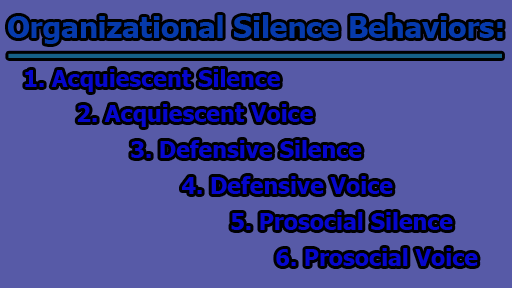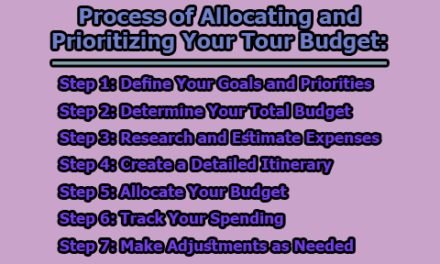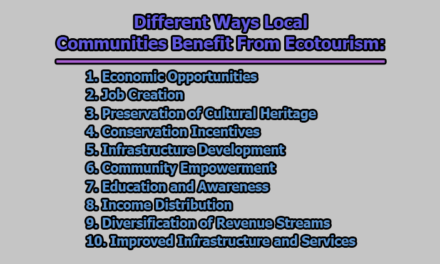The concept of organizational silence refers to the phenomenon in which employees withhold their thoughts, ideas, concerns, or feedback within an organization. It can have profound implications for an organization’s performance, employee well-being, and overall effectiveness. To understand the development of organizational silence, it’s essential to explore the different behaviors associated with it. In this article, we will delve into organizational silence behaviors, exploring their development, implications, and ways organizations can manage and promote constructive silence and voice.
Organizational Silence Behaviors:
Dyne, Ang, and Botero (2003) proposed a framework that categorizes organizational silence into six specific behaviors based on three employee motives: Acquiescent Silence, Acquiescent Voice, Defensive Silence, Defensive Voice, Prosocial Silence, and Prosocial Voice.
1. Acquiescent Silence: Acquiescent Silence is characterized by employees’ passive compliance with organizational decisions and practices, even when they disagree or have concerns. This behavior often stems from motives like fear of retaliation, job insecurity, or a lack of trust in the organization’s receptivity to feedback. To understand the development of Acquiescent Silence, it’s essential to consider the following factors:
a. Fear of Retaliation: Employees may remain silent due to fear of negative consequences, such as retribution, criticism, or being sidelined in the organization.
b. Job Insecurity: Job insecurity can lead employees to withhold their opinions to avoid drawing attention to themselves and potentially jeopardizing their positions.
c. Lack of Trust: Employees may perceive that the organization does not genuinely value their input, leading them to remain silent to avoid wasting time or being ignored.
d. Development and Consequences: Acquiescent Silence can have detrimental consequences for an organization. When employees don’t voice their concerns or suggestions, it can lead to poor decision-making, missed opportunities, and a lack of innovation. Additionally, it can contribute to a toxic work environment, where employees feel disengaged and demotivated.
2. Acquiescent Voice: Acquiescent Voice represents a situation where employees express agreement with organizational decisions and practices, even when they genuinely disagree. The development of Acquiescent Voice often involves motives such as a desire to conform, maintain harmony, or gain favor within the organization. Here are key points to consider regarding this behavior:
a. Desire for Conformity: Some employees may feel the need to conform to group norms or expectations, leading them to voice agreement even when they hold different opinions.
b. Harmony Maintenance: Individuals may engage in Acquiescent Voice to avoid conflict and maintain a harmonious workplace, as they perceive disagreement as disruptive.
c. Favor Seeking: Employees may use Acquiescent Voice as a means to gain favor with supervisors or colleagues, believing that agreeing with them will lead to personal benefits.
d. Development and Consequences: While Acquiescent Voice may initially appear beneficial in terms of maintaining harmony, it can stifle constructive discourse and hinder innovation. Employees may become complacent, and the organization may miss out on valuable input and diverse perspectives.
3. Defensive Silence: Defensive Silence refers to the withholding of critical feedback or concerns due to fear of negative consequences or a belief that the organization will not address the issues constructively. The development of this behavior often involves motives related to self-preservation and minimizing risk. Here are some key points to consider:
a. Self-Preservation: Employees may remain silent to protect themselves from potential backlash or retaliation if they were to speak up about problems or issues.
b. Risk Aversion: The fear of negative repercussions, such as being labeled a troublemaker or experiencing professional setbacks, can deter employees from sharing their concerns.
c. Lack of Problem Resolution: Employees may have observed that past instances of raising concerns have not resulted in positive change, leading to a belief that it’s futile to voice their worries.
d. Development and Consequences: Defensive Silence can lead to the persistence of organizational issues and inefficiencies. By failing to address problems or engage in open dialogue, an organization risks stagnation and may miss opportunities for improvement.
4. Defensive Voice: Defensive Voice is a behavior where employees express concerns or criticism but do so in a cautious or guarded manner. It often arises from a desire to raise issues while minimizing the risk of negative consequences. To understand the development of Defensive Voice, the following factors are important:
a. Cautious Communication: Employees may carefully frame their concerns, choosing their words and tone to avoid offending or antagonizing others.
b. Risk Mitigation: Defensive Voice is motivated by the desire to address issues while minimizing the potential fallout, such as negative reactions from colleagues or supervisors.
c. Development and Consequences: While Defensive Voice is a step towards open communication, it may not lead to the resolution of core problems. Employees may feel their concerns are not adequately addressed, which can lead to persistent issues and frustration.
5. Prosocial Silence: Prosocial Silence is characterized by employees choosing not to voice their concerns or criticism because they believe it would be detrimental to others or the organization. The development of this behavior often involves motives related to empathy and concern for the collective well-being. Key considerations include:
a. Empathy and Altruism: Employees may remain silent out of concern for how their feedback might negatively affect others, such as colleagues or the organization as a whole.
b. Collective Well-Being: Prosocial Silence is motivated by the belief that raising certain issues may be disruptive or harmful to the organization’s overall performance or morale.
c. Development and Consequences: While Prosocial Silence reflects a degree of selflessness, it can still hinder an organization’s growth and effectiveness. Critical issues may remain unaddressed, leading to long-term negative consequences.
6. Prosocial Voice: Prosocial Voice involves employees speaking up about concerns or suggestions for the betterment of others or the organization. This behavior is rooted in motives such as altruism, a desire for organizational improvement, and a strong sense of responsibility. To understand the development of Prosocial Voice, the following factors are important:
a. Altruism and Empathy: Employees engaging in Prosocial Voice are motivated by a genuine concern for the well-being of colleagues, the organization, or its stakeholders.
b. Desire for Improvement: Prosocial Voice is driven by a strong belief in the potential for positive change and the desire to contribute to organizational growth and well-being.
c. Development and Consequences: A Prosocial Voice is essential for organizational success, as it can lead to constructive change, innovation, and the resolution of long-standing problems. Encouraging and recognizing this behavior can create a culture of open communication and continuous improvement.
Development of Organizational Silence:
Organizational silence, in its various forms, can develop for a range of reasons, including organizational culture, leadership style, and individual factors. Some key factors contributing to the development of organizational silence include:
1. Leadership Style: Leadership style is a fundamental factor in shaping the behavior of employees when it comes to speaking up or remaining silent within an organization. Different leadership styles can either encourage or discourage various forms of silence:
a. Authoritarian Leadership: Authoritarian leaders tend to make decisions unilaterally and may not be open to dissenting opinions. In such environments, employees are more likely to exhibit Acquiescent Silence, as they fear repercussions for voicing their concerns.
b. Punitive Leadership: Leaders who employ punitive measures, such as criticism or punishment, when employees express differing viewpoints can create an atmosphere of fear. This environment often leads to Defensive Silence, where employees keep their concerns to themselves to avoid negative consequences.
c. Transformational Leadership: Transformational leaders encourage open dialogue, constructive feedback, and innovation. They inspire their teams, creating an environment where Prosocial Voice is more likely to thrive.
d. Servant Leadership: Servant leaders prioritize the well-being and development of their employees. In such environments, employees tend to feel valued and supported, which can lead to increased Prosocial Voice.
e. Democratic Leadership: Leaders who involve employees in decision-making and welcome their input are more likely to foster Prosocial Voice, as employees feel that their opinions are valued.
2. Organizational Culture: Organizational culture is a critical determinant of whether employees feel comfortable sharing their thoughts and concerns. The prevailing culture significantly influences whether constructive silence and voice are encouraged:
a. Innovative and Inclusive Culture: An organization that values diversity of thought, encourages constructive criticism, and supports innovation is more likely to foster Prosocial Voice. Employees feel safe expressing their ideas and concerns, believing that their input contributes to positive change.
b. Hierarchical and Authoritarian Culture: In organizations with rigid hierarchies and a culture that stifles dissent, Acquiescent Silence and Defensive Silence are more prevalent. Employees may fear backlash or believe their opinions will be disregarded.
c. Safety Culture: A culture that prioritizes safety (both physical and psychological) can lead to higher levels of Prosocial Voice. When employees perceive that the organization cares about their well-being, they are more likely to speak up about safety concerns.
3. Psychological Safety: The perception of psychological safety plays a crucial role in shaping whether employees feel comfortable sharing their thoughts and concerns. This concept, popularized by Amy Edmondson, refers to the belief that one can speak up without fear of negative consequences:
a. High Psychological Safety: In environments with high psychological safety, employees feel secure expressing their ideas, raising concerns, and providing constructive feedback. This fosters Prosocial Voice, as employees trust that their input is valued and that they won’t face retaliation.
b. Low Psychological Safety: In contrast, low psychological safety leads to various forms of silence. When employees perceive that speaking up might lead to negative consequences, they are more inclined toward Acquiescent Silence, Defensive Silence, or Acquiescent Voice.
c. Building Psychological Safety: Organizations can actively work to create a culture of psychological safety by encouraging open communication, actively listening to employee concerns, and demonstrating a commitment to addressing issues constructively.
4. Communication Channels: The availability and effectiveness of communication channels within an organization also significantly influence the development of silence:
a. Accessible Feedback Mechanisms: Organizations that provide accessible and effective feedback mechanisms, such as suggestion boxes, regular surveys, and open-door policies, encourage Prosocial Voice. When employees believe their feedback will be received and acted upon, they are more likely to speak up.
b. Lack of Communication Avenues: When employees perceive a lack of channels for expressing their concerns, they are more inclined toward Acquiescent Silence and Defensive Silence. In such cases, they may choose to remain silent due to a lack of viable options for sharing their thoughts.
5. Past Experiences: Employees’ past experiences within the organization significantly impact their willingness to speak up:
a. Positive Past Experiences: Employees who have had positive experiences with speaking up and have seen their concerns addressed constructively are more likely to engage in Prosocial Voice. Positive feedback loops can encourage employees to continue providing valuable input.
b. Negative Past Experiences: Conversely, if employees have witnessed colleagues or themselves facing negative consequences for sharing feedback, they may be more inclined toward silence. Negative experiences can lead to the development of Acquiescent Silence and Defensive Silence.
c. Building Trust: Organizations can rebuild trust by demonstrating a commitment to addressing past issues and creating an environment where feedback is genuinely valued.
Consequences of Organizational Silence:
The consequences of organizational silence can be far-reaching and impact both individuals and the organization as a whole. Understanding these consequences is essential for appreciating the importance of addressing silence within the workplace:
1. Reduced Innovation: Organizational silence can significantly hinder innovation, which is crucial for an organization’s growth and competitiveness:
a. Stifled Creativity: When employees do not feel comfortable sharing new ideas or pointing out flaws in existing processes, innovation is stifled. Many potentially groundbreaking ideas may go unexpressed.
b. Missed Opportunities: Innovative ideas and solutions are often born from diverse perspectives and open discussions. When employees remain silent, opportunities for improvement and innovation are missed.
c. Competitive Disadvantage: In a rapidly changing business landscape, organizations that fail to innovate may struggle to compete effectively. A culture of silence can hamper an organization’s ability to adapt to market shifts and technological advancements.
2. Poor Decision-Making: Effective decision-making is a cornerstone of organizational success. Organizational silence can undermine this critical aspect in several ways:
a. Incomplete Information: When employees withhold critical information or concerns, leaders may lack the vital data needed to make informed choices. This can result in suboptimal decisions.
b. Groupthink: Without diverse perspectives and open discussions, organizations may fall prey to groupthink, where decision-makers conform to a consensus, potentially ignoring viable alternatives or risks.
c. Inadequate Problem Solving: Unresolved issues that result from silence can lead to persistent problems. Decision-makers may attempt to address symptoms rather than the root causes of issues.
3. Workplace Disengagement: A culture of silence can lead to disengagement and demotivation among employees, affecting their overall job satisfaction and commitment:
a. Voice Suppression: When employees perceive that their voices are not valued, they may choose to disengage and withhold discretionary effort. They might question the purpose of sharing their ideas when it seems that nobody is listening.
b. Lack of Ownership: Employees who don’t feel they have a say in shaping their work environment or contributing to solutions may become passive and disengaged, which can negatively impact their performance and commitment.
c. Demoralization: Over time, a culture of silence can lead to demoralization among employees, resulting in higher turnover rates and difficulties in retaining top talent.
4. Reputation Damage: An organization known for suppressing voice or ignoring concerns can suffer damage to its reputation:
a. Employee Perception: When employees experience silence within the organization, they may form a negative perception of it. This perception can spread through word-of-mouth and negatively affect the organization’s image as an employer.
b. External Perception: News of internal issues or a lack of innovation can also reach external stakeholders, such as customers, partners, or investors. This can erode trust and impact the organization’s reputation.
c. Talent Attraction and Retention: A tarnished reputation can make it difficult for the organization to attract and retain top talent, further hindering its growth and success.
5. Conflict Escalation: Organizational silence can lead to pent-up frustration and unresolved issues, potentially resulting in more significant conflicts or crises:
a. Unresolved Concerns: When employees consistently suppress their concerns, these issues can fester over time. They may escalate into more significant problems, making resolution more challenging.
b. Crisis Potential: In extreme cases, the accumulation of unaddressed concerns can lead to crises within the organization. It may result in public scandals, legal issues, or severe disruptions in operations.
c. Damage to Relationships: The persistence of silence and unresolved conflicts can harm working relationships, trust, and collaboration among employees, further deteriorating the organizational climate.
Promoting Constructive Silence and Voice:
To address and manage organizational silence effectively, organizations can take several proactive steps:
1. Foster Psychological Safety: Create an environment where employees feel safe expressing their opinions, ideas, and concerns without fear of retribution.
a. Open Communication Channels: Establish a culture of open communication where employees are encouraged to voice their concerns, ideas, and opinions. Ensure that various channels, both formal and informal, are available for this purpose.
b. Non-Retaliation Policy: Clearly communicate a non-retaliation policy, assuring employees that they will not face negative consequences for speaking up. This policy should be consistently enforced to build trust.
c. Leadership Role: Leaders should actively demonstrate and endorse the importance of psychological safety. They should encourage open and honest discussions, be approachable, and actively listen to employees’ concerns.
2. Leadership Training: Train leaders to promote open communication, actively listen to employees, and respond constructively to feedback.
a. Communication and Empathy Training: Provide leaders with training in effective communication and empathy. This training should focus on active listening, providing constructive feedback, and fostering an environment where employees feel heard and valued.
b. Conflict Resolution Skills: Equip leaders with conflict resolution skills to address and manage disagreements and concerns in a fair and constructive manner. This includes training on mediation and negotiation techniques.
3. Feedback Mechanisms: Establish clear and accessible feedback channels, such as suggestion boxes, regular surveys, and open-door policies.
a. Accessible Channels: Establish clear and accessible feedback mechanisms, including suggestion boxes, regular surveys, anonymous reporting options, and open-door policies. These channels should be designed to accommodate different communication preferences and comfort levels.
b. Timely Response: Ensure that feedback is acknowledged and addressed in a timely manner. This demonstrates the organization’s commitment to valuing employee input.
4. Recognition and Reward: Recognize and reward employees for speaking up and contributing to positive change within the organization.
a. Acknowledgment: Recognize and publicly acknowledge employees who speak up or contribute valuable ideas. Celebrate their proactive approach to problem-solving and innovation.
b. Incentives: Consider implementing incentive programs that reward employees for their contributions to positive change within the organization. These incentives can be both monetary and non-monetary.
5. Conflict Resolution Processes: Develop efficient conflict resolution processes to address issues and concerns in a fair and constructive manner.
a. Structured Procedures: Develop and communicate structured conflict resolution processes that provide employees with a clear path to addressing their concerns. Ensure these processes are fair and impartial.
b. Mediation Resources: Offer mediation services to facilitate productive discussions and negotiations when conflicts arise. Mediators can help parties find common ground and reach mutually acceptable resolutions.
6. Training and Education: Provide training and education on effective communication, conflict resolution, and the value of diverse perspectives.
a. Effective Communication Training: Provide training on effective communication for all employees, emphasizing the importance of clear and respectful expression of ideas, active listening, and providing constructive feedback.
b. Diversity and Inclusion Training: Offer education on the value of diversity and inclusion in the workplace. This training can help employees appreciate the benefits of diverse perspectives and encourage them to embrace differences in thought and background.
7. Lead by Example: Leaders should set a precedent by openly sharing their concerns, being receptive to feedback, and demonstrating the importance of constructive silence and voice.
a. Transparent Leadership: Leaders should set the example by being transparent about their concerns and uncertainties. This transparency helps create an environment where employees feel comfortable sharing their thoughts.
b. Receptive to Feedback: Leaders must actively seek feedback from their teams and demonstrate that they are open to receiving criticism and suggestions. By responding constructively, leaders reinforce the importance of constructive silence and voice.
8. Periodic Assessments: Regularly assess the organizational culture and employees’ perceptions to identify areas where silence may be prevalent.
a. Culture Surveys: Conduct regular culture and engagement surveys to assess employees’ perceptions regarding open communication, psychological safety, and the prevalence of silence. Use the feedback to identify areas of improvement.
b. Continuous Improvement: Act on the findings of these surveys by making necessary changes and improvements. This demonstrates a commitment to addressing organizational silence and fostering a culture of openness.
In conclusion, organizational silence, encompassing behaviors like Acquiescent Silence, Acquiescent Voice, Defensive Silence, Defensive Voice, Prosocial Silence, and Prosocial Voice, has a profound impact on organizations. The development of silence is influenced by leadership, culture, psychological safety, and past experiences. It can result in reduced innovation, poor decision-making, and workplace disengagement.
To address and manage silence effectively, organizations should focus on fostering psychological safety, training leaders, providing feedback mechanisms, recognizing and rewarding constructive voices, and leading by example. By promoting a culture of constructive silence and voice, organizations can unlock the full potential of their employees and achieve greater success in an ever-evolving and competitive business landscape.
References:
- Dyne, Ang, and Botero (2003). Conceptualizing Employee Silence and Employee Voice as Multidimensional Constructs. Journal of Management Studies, 40:6, 0022-2380.
- Ehtiyar, M. Yanardağ (2008). Organizational Silence: A Survey on Employees Working in a Chain Hotel. Tourism and Hospitality Management, Vol. 14, No. 1, pp. 51-68.
- Henriksen, Kern, Dayton, Elizabeth, (2006). Organizational Silence and Hidden Threats to Patient Safety. HSR: Health Services Research, 41:4, Part II, 1539-1554.
- Huang, Xu, Van De Vliert, Evert, Van Der Vegt, Gerben (2005). Breaking the Silence Culture: Stimulation of Participation and Employee Opinion Withholding Cross-nationally. Management and Organization Review, 1:3, 1740-8776.
- Milliken, Frances J., Morrison, Elizabeth W., Hewlin, Patricia E. (2003). An Exploratory Study of Employee Silence: Issues that Employees Don’t Communicate Upward and Why. Journal of Management Studies, 40:6 September, 1454-1476.

Assistant Teacher at Zinzira Pir Mohammad Pilot School and College










